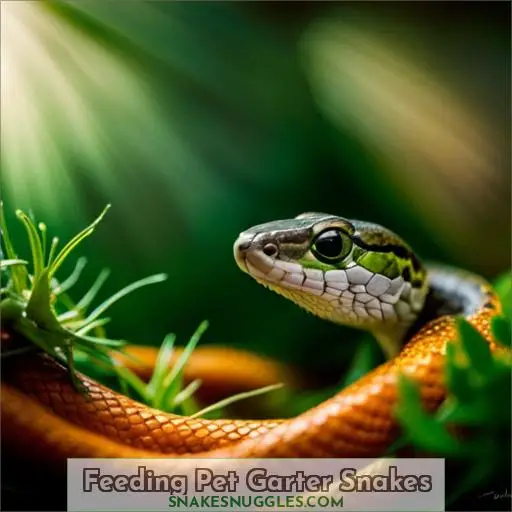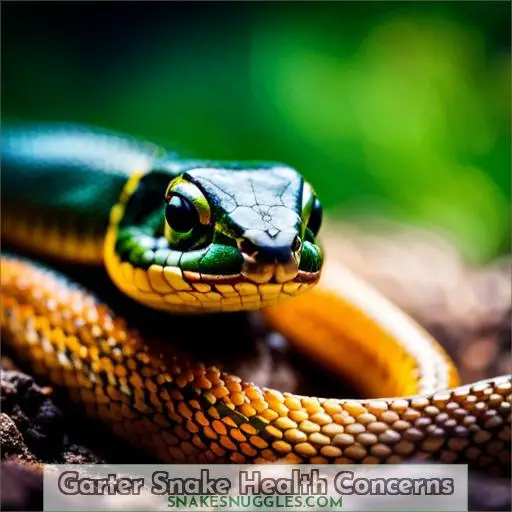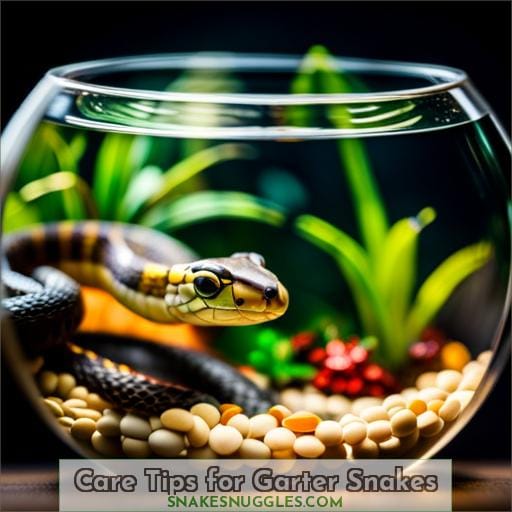This site is supported by our readers. We may earn a commission, at no cost to you, if you purchase through links.

Look no further than the garter snake.
Small but lively, these snakes thrive in properly set up habitats.
Their varied diet is simple to provide.
Though small, garter snakes have big personalities – they’re curious and alert critters.
Few health issues plague them when cared for correctly.
Best of all, garter snakes pose no risk to humans.
Their gentle dispositions make them snake newbies’ top choice for captivity.
Table Of Contents
Key Takeaways
- Provide an appropriately sized enclosure with adequate temperature gradient, humidity, hiding spots, and furnishings.
- Offer a varied diet including worms, feeder fish/amphibians, and thawed rodents based on the snake’s age and size.
- Garter snakes generally have calm dispositions and become tame with gentle handling.
- Perform proper maintenance like daily spot cleans, weekly deep cleans, and regular veterinary checkups.
Acquiring Garter Snakes
Avoid acquiring wild garter snakes to keep as pets.
When looking to obtain a garter snake, purchase your pet from reputable sources like pet stores, breeders, or rescue organizations.
A thorough veterinary examination helps ensure your new snake’s health before bringing it home.
Avoid Wild-Caught Snakes
You’ll want to avoid keeping wild garter snakes as pets.
They have a higher risk of parasites and difficulty adapting to captivity.
Instead, obtain garter snakes from ethical breeders, reputable pet stores, or rescue organizations.
They can provide credentials for their breeding practices and animal care.
Prioritize captive-bred snakes from sources focused on garter snake health, proper husbandry, and veterinary attention.
This is over risky and unethical wild snake capture.
Purchase From Reputable Sources
You should always obtain garter snakes from rescue organizations, pet stores, or reputable breeders that frequently provide thorough examinations by snake-savvy veterinarians.
Seek breeder recommendations from local reptile clubs and enthusiasts.
Ask to see veterinary records for any snake under consideration.
Check online reviews of sellers before making a purchase.
Visit reptile expos to meet sellers and view stock firsthand.
Housing Needs for Garter Snakes
When setting up an enclosure for your garter snake, consider the ideal adult tank size, such as a 20-gallon long tank for adult similar snake species, carefully consider tank size and proper substrates.
An appropriately sized tank and high-quality substrates are crucial for your snake’s health and well-being.
In the following section, we’ll delve further into ideal tank sizes for garter snakes as well as substrate recommendations.
Tank Size and Setup
Provision of adequate tank space facilitates a garter snake’s health and wellbeing.
You’ll want to set up an enclosure at least as long as the fully-grown snake and outfit it with proper heating, lighting, and places to hide.
Adult snakes require 30- to 50-gallon tanks with secure lids, a shallow water bowl, under-tank or over-tank heat sources, a hide box, rocks for rubbing, and paper-based substrates for burrowing.
Perform daily spot cleaning and weekly full cleanings.
Proper Substrate
Its enclosure requires paper-based bedding, like shredded newspaper or butcher paper, for burrowing and hiding.
Opt for substrates like shredded paper that allow for burrowing behaviors while controlling moisture to prevent scale rot.
Perform full cleanings weekly, replacing soiled bedding daily.
DIY hiding spots from cardboard tubes or boxes give additional enrichment.
Proper substrates aid natural behaviors and health in garter snake housing.
Feeding Pet Garter Snakes
When it comes to feeding your pet garter snake, providing a varied diet is key for proper nutrition.
Offer items like earthworms, feeder fish, frogs, toads, and rodents.
Feed adults every 7-10 days while younger snakes can be fed more frequently.
Pay attention to your snake’s age, size, and activity level to determine the ideal feeding amount and schedule.
Varied Diet is Key
Your garter snake’s diet should include a variety of prey for proper nutrition:
- Earthworms
- Feeder fish
- Frogs
- Toads
- Frozen-thawed rodents
Offer a diverse menu including these items. This dietary diversity provides balanced nutrition.
Feed adults 7-10 days apart. More frequent feeds are needed for growing or gravid snakes.
Even finicky garters can be tempted by rotating culinary options while monitoring for consistent appetite and waste elimination.
How Often to Feed
You’ll want to feed adult snakes according to their size every 7-10 days.
Younger or pregnant snakes need feeding more frequently at 4-5 day intervals to support their growth and reproduction.
Offer an appropriately sized frozen-thawed rodent at each meal.
Supplement with calcium and vitamins.
Garter Snake Temperament
Most garter snakes have a personality that can be categorized as "bold" or "shy" based on their behavior, which affects their social interactions and survival strategies, often influenced by environmental factors like predator pressure and food. Most garter snakes have an even temperament, though you’ll find some variation between individual animals.
They tend to be quite docile and tolerate regular handling.
Garter snakes seldom bite, even when stressed.
They can make great pets for novice and experienced keepers alike.
However, garter snakes may musk or defecate when frightened.
Provide hides and limit handling after feeding to prevent this.
Once acclimated, garter snakes become quite tame and interactive.
Use positive reinforcement when handling to build trust over time.
Overall, garter snakes have agreeable dispositions suitable for many owners.
Their generally calm nature makes them one of the best snake species to consider for first-time snake enthusiasts.
Garter Snake Health Concerns
Garter snakes tend to stay healthy when given proper care, but you’re at risk of parasites, nutritional issues, or illness from cool tanks.
Many snakes harbor gastrointestinal parasites that can transmit to humans, so practice good hygiene.
Offer a balanced, varied diet to prevent nutritional imbalances from overfeeding certain prey items.
Ensuring a proper cage size, such as one that is at least as long as the snake’s full length and half as wide, as discussed in choosing the right snake cage, can help prevent health issues. Overweight snakes may result from inadequate cage size and exercise.
Maintain proper warm and cool temperature gradients using heat mats, lamps, or supplemental heating as needed.
Provide UV lighting, as you would sunlight, to facilitate vitamin D3 production for bone health.
Overall, parasite prevention, nutritional balance, temperature management, exercise, and UV exposure all promote garter snake health and prevent common issues like shedding problems.
The Good and Bad of Garter Snakes as Pets
When considering garter snakes as pets, you’ll want to weigh their positive and negative qualities.
On the plus side:
- They’re small.
- They’re attractive.
- They’re unlikely to bite.
However:
- They can be messy.
- They can be smelly.
- They can be challenging for novice owners.
Review both the pros and cons to determine if a garter snake is the right exotic pet for your situation.
Positive Traits
Tank Setup, Feeding, Health and More Care Tips:
For many folks, garter snakes’ small size, which is easy to house in captivity, is a big plus as a pet snake choice. Their attractive patterns appeal to some keepers, while others may prefer their gentle handling traits compared to some more irascible species.
The overall rarity of attempting to bite makes garter snakes ideal interaction pets for all ages if provided proper habitat decor and enrichment activities based on careful behavioral observations and handling tips.
Negative Traits
However, you’ll find garter snakes can discharge musk, urates, or feces when handled, which is unpleasant.
What’s more, most offered for sale are probably wild-caught, making them harder to care for.
Handling Challenges
Odor Management
Venomous Misconceptions
Behavioral Insights
Captive Breeding
Care Tips for Garter Snakes
When keeping garter snakes as pets, providing proper temperatures and lighting is crucial for their health and wellbeing.
You’ll need to set up a temperature gradient in the tank, with warmer and cooler areas for them to self-regulate.
Regular veterinary checkups are also essential to monitor for any developing health issues, even if your snake seems perfectly healthy.
Proper Temperatures
You’ll need a temperature gradient:
- Warm end in the 80s°F
- Cool end above 70s°F
Provide a 90s°F basking spot with UV lighting on 10-12 hours a day.
Use supplemental heating sources to maintain appropriate overnight temperatures.
Humidity should be 40-60%.
| Day | Night | |
|---|---|---|
| Warm End | 80s°F | 75°F |
| Cool End | 70s°F | 70°F |
| Basking Spot | 90s°F | Off |
| Humidity | 40-60% | 40-60% |
Lighting Needs
Additionally, you should:
- Keep lights on for 10-12 hours per day and turned off at night to mimic the natural day-night cycle.
- Provide a basking spot with a UV bulb mimicking the sun.
- Supplemental heat may be necessary to maintain appropriate temperatures during day and night.
Veterinary Care
In addition, you should schedule regular veterinary checkups for your garter snake:
- Initially upon getting it
- Annually thereafter, even if it seems healthy
These visits allow preventative care through:
- Parasite prevention
- Nutrition tips
- Habitat evaluations
- Age-based health insights
For proper tank setup, feeding, and addressing any concerns.
Are Garter Snakes Good Pets for You?
Tank Setup, Feeding, Health and More Care Tips:
Your decision about whether garter snakes make good pets for your home depends on thoughtfully weighing their positive and negative traits against your needs and preferences as an owner.
While garter snakes can make engaging interactive pets, requirements like frequent tank cleaning or appropriately sized feeder rodents may not suit all owners.
Those willing to properly research garter snake care including tank setup, feeding, health monitoring and enrichment ideas can find these snakes to be hardy, long-lived captives.
Handling tips like supporting the snake’s body or wearing gloves can make interactions more pleasant.
Overall, garter snakes can thrive when owners commit to understanding and meeting their needs.
Frequently Asked Questions (FAQs)
What species of garter snake stays the smallest?
The Checkered Garter Snake is the smallest species of garter snake, usually growing to only 18-23 inches as adults.
This small, colorful breed becomes popular among garter snake enthusiasts for its manageable size and vibrant patterning.
How can I train my garter snake?
Unfortunately, garter snakes aren’t easily trainable.
While some keepers report modest success using food rewards for basic behaviors, garter snakes lack the cognitive complexity required for extensive training.
Focus instead on providing a stimulating habitat that allows them to exhibit natural behaviors.
What signs indicate my garter snake may be gravid (pregnant)?
If your garter snake ceases eating, its body thickens, or you see bulges, she may be pregnant.
Check for enlarged ovaries by gently palpating the lower third of her body.
An X-ray can confirm pregnancy.
Move a gravid snake to a separate enclosure until after birth.
Is a male or female garter snake better as a pet?
Female garter snakes tend to grow larger, but otherwise, both sexes make equally enjoyable pets.
Focus on selecting a calm, established captive-bred individual, regardless of gender.
Can I let my garter snake play outside of its enclosure?
Let your garter snake roam cautiously.
Though stimulating, unsupervised time risks injury or escape.
Always closely monitor and limit play to a secure, snake-proofed area.
Conclusion
Have you ever considered bringing one of these harmless yet lively reptiles into your home?
If you seek an interactive pet that’s easy to care for, garter snakes check all the boxes.
Their small size belies their big personalities – these curious and alert critters make for engaging companions.
As long as you provide the proper habitat and diet, garter snakes should thrive under your care, posing little health risk with their gentle dispositions.
So why not give these popular starter snakes a shot?
You just may find these critters to be the perfect pet.














